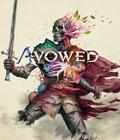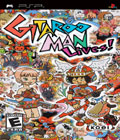Genre: Rhythm
Publisher: KOEI
Developer: KOEI
Release Date: November 14, 2006
Though I have been a fan of rhythm games for several years, I do have a sad confession to make: I never played Gitaroo Man for the PlayStation 2. I didn't bother check it out when it first released in 2002, assuming it would languish on shelves for some time, just as Stretch Panic had done the previous year. But it came and went, perhaps never to be seen again. Surprisingly, it reappeared on those same store shelves in 2005, when GameStop started selling reprints for $39.99, and even then, I passed up the opportunity to play it. If you want to kick me out of the club, I understand, but know this: I bought Samba de Amigo on day one, maracas and all.
Are we cool again? Do I have a little bit of rhythm gaming credibility? All right, I screwed up the first time, but I was not about to pass up a fresh opportunity to play this cult classic. Gitaroo Man Lives! for the PlayStation Portable is a pitch-perfect port of the PS2 original. Everything you loved the first time is back, along with two new levels (albeit outside of the story mode) and ad-hoc wireless multiplayer. Though the widescreen display and finicky analog nub of the PSP compromise the experience just a bit, Gitaroo Man Lives! is an excellent way to rock out on the go.
As you have hopefully deciphered, Gitaroo Man Lives! is mainly concerned with the guitar as an instrument, though this isn't exactly a battle of the bands. Instead, the guitar (or "gitaroo") is used as a weapon to vanquish foes. Main character U-1 was a simple boy pining after the girl of his dreams until his dog Puma taught him how to play the guitar. While doing so, Puma revealed that U-1 is actually the long-lost hero of Planet Gitaroo, and that he can transform into Gitaroo-Man during battle.
Though Gitaroo Man Lives! and Guitar Hero both focus on the same instrument, the similarities end there. The most notable difference deals with the actual input of commands; while Guitar Hero requires the SG guitar-shaped controller, Gitaroo Man Lives! uses only the analog stick and face buttons of the PSP. Though Guitar Hero uses songs you might hear on the radio or have heard in years past, Gitaroo Man Lives! features a line-up of original songs, many in Japanese. Because of these differences, Gitaroo Man Lives! is more akin to the Parappa the Rapper series, especially the offshoot game Um Jammer Lammy. Though the actual gameplay is much different, both titles are character-driven and rely on a handful of unique tracks in lieu of a huge list of licensed songs.
The story mode in Gitaroo Man Lives! features 10 stages and a tutorial, with most of the stages following a set pattern. First up is the Charge phase, in which you must fill up your life bar before engaging in battle with your enemy. A small blue circle is planted in the center of the screen, and the analog nub of the PSP is used to control it. By aiming the nub in a direction, you activate a cone of light that emanates from the on-screen circle. During the charge phase, a Trace Line containing notes will come from off-screen, and you must keep that line in your cone of light at all times to execute the notes.
So long as the Trace Line is in your cone of vision, you can hit the notes, which are called Phrase Bars. Each and every Phrase Bar is signified by an orange circle, and surprise surprise, you activate it by pressing and holding the Circle face button of the PSP. The Circle button is the only one used to activate Phrase Bars, so the game is not overly complicated in that sense. However, the Trace Line may wiggle around the screen in the advanced levels, so it is your responsibility to make sure the line is always highlighted by using the analog nub. The Phrase Bars in the Charge phase are usually simplistic, as you will need as much life as you can get before entering the Battle phase.
Here is where Gitaroo Man Lives! becomes pretty complicated. The Battle phase requires you to both attack and defend, which are entirely different activities. Attacking is exactly like it is in the Charge phase, with the Trace Line and Phrase Bars. However, as noted, the Trace Line may become unruly and move haplessly across the screen. If you do not highlight the line for the entirety of a Phrase Bar, it will deactivate and you will take damage for missing the attack. Additionally, the Phrase Bars contain a significant amount of variety, alternating between staccato notes and those that must be held.
While defending, the analog nub is no longer in play, though you must use all four of the PSP's face buttons. Guard Marks will come from each side of the screen, but thankfully, they always come from the same direction (Triangle from the top, Circle from the right, X from the bottom, and Square from the left). This is one instance in which the widescreen display of the PSP actually hinders the experience to some extent. See, the Guard Marks from the left and right spend more time on the screen before they hit the center; therefore, the top and bottom Guard Marks pop up with much less notice. So while you are planning to hit the Square and Circle buttons, an X or Triangle Guard Mark may pop up and sabotage your idea.
Without hesitation, I can clearly state that the defensive part of the Battle phase is the most difficult part of the game. Early on, the Guard Marks typically come one or two at a time, and they're fairly manageable. As you advance through the game, the Marks come faster and in bunches, and the proportions of the screen make timing your button presses rather challenging. As both a drummer and a longtime rhythm gamer, I found the hitting of Guard Marks to be tough, but not particularly impossible on the Normal difficulty. However, newbies to the genre or those without a sense of rhythm should have a rough go of it.
The Final phase is naturally last, and is similar to the Charge phase in that neither uses the Guard Marks; it's all about Trace Lines and Phrase Bars. The key difference here is that missing these notes will cause you to take damage, and you may be near the end of your life bar following a particularly tough Battle phase. The Final phase typically uses several epic Phrase Bars, though there may be some difficult combinations involved. Get through it, and you will thankfully be onto the next stage.
My only other issue with the PSP hardware in regards to Gitaroo Man Lives! has to do with the tiny analog nub. A sweaty thumb will slide around much more easily, and the nub simply is not as precise as a PlayStation 2 analog stick. Even if you have perfected the game on the PS2, you may find yourself making little errors on the PSP version.
The dozen or so songs in Gitaroo Man Lives! cover a wide range of genres, including J-pop, metal, acoustic, and reggae. I only noted English lyrics in one of the tracks, though the lyrics were not clearly sung over the instrumentation. Due to the lack of English lyrics, the songs are not quite as memorable as those of the original Parappa the Rapper, but there are twice as many songs included.
Visually, the game is vibrant and solidly rendered, though the colorful character models in the background sometimes made it tough to keep up with the button presses. On the other hand, the CG animation is absolutely atrocious and seems like it is from the early 1990s. Comparing the CG in Gitaroo Man Lives! to that of Final Fantasy XII would be like comparing the stop-motion animation of "The Nightmare Before Christmas" to that of the show "Gumby." While I doubt the developers were aiming for realism, the actual animations leave entirely too much to be desired.
It takes roughly an hour to complete the story mode on the Normal difficulty level, though you will likely play it more than once. The masochists out there should give the Master difficulty a shot as well. Outside of story mode, you can play the stages against the computer or as a duet with a supporting character. Two new songs, "Toda Pasión" and "Metal Header," are available for play as duets. If you and your buddy both have the game, you can face off wirelessly via ad-hoc multiplayer, though I would have preferred an Infrastructure mode. The other extras are fairly insignificant; the Theatre and Jukebox modes let you check out the media from the game, and the Collection allows you to read about the in-game characters via unlockables from the story mode.
Gitaroo Man Lives! is an excellent title that is somewhat undermined by its lack of content. True, it may have twice the stages of offerings like Parappa the Rapper, but gamers expect a bit more for their investment these days. That said, those who can stomach the thin dollar-to-gameplay ratio are in for a great time, especially since Gitaroo Man Lives! is one of the only rhythm gaming options on the system. A longer story mode and an Infrastructure multiplayer mode would have sealed the deal, but as it is, Gitaroo Man Lives! is still one of the best rhythm titles on the market.
Score: 8.2/10
More articles about Gitaroo Man Lives!












 With his unique collection of battle songs and his talents for blazing out shark shattering anthems, Gitaroo Man is tuned up and ready to hit the road. Gitaroo Man Lives! makes clever use of the PSPs analogue controls and includes brand new wi-fi games where two tunesmiths can either join forces or pit their talents against each other to see who is the ultimate string legend.
With his unique collection of battle songs and his talents for blazing out shark shattering anthems, Gitaroo Man is tuned up and ready to hit the road. Gitaroo Man Lives! makes clever use of the PSPs analogue controls and includes brand new wi-fi games where two tunesmiths can either join forces or pit their talents against each other to see who is the ultimate string legend.
















































